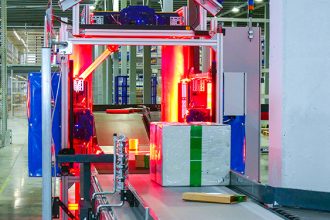From Preventative to Predictive Maintenance of Automation

All material handling equipment needs regular maintenance to stay in top condition and for many years, preventative maintenance has been the ideal model for warehousing staffs to follow. It involves establishing a regular schedule for inspecting equipment and replacing components, hopefully keeping equipment humming without disruption to operations. The concept centers around an expected timing of failure, and preventing that from taking place.
One step better, however, is having the ability to collect data about equipment, monitoring components so that you know when they might actually fail. Then, you can schedule downtime to replace the part accordingly, and extend the life of the equipment. For instance, with a conveyor, you would collect data on the motor, monitoring vibration, analyzing that information to determine when it might fail. In a nutshell, maintenance becomes usage based rather than schedule based.
In order to achieve the ideal of predictive maintenance, companies must first put several pieces in place in order to gather the necessary information.
The first is sensors. In the case of conveyors and sortation, that looks like sensors—on motors, and on all the moving parts that can deliver measurable data points. Often, these are built in to automation products. Temperature, vibrations, the identification of low performance points throughout the day, and other metrics that help predict when the equipment could use maintenance in order to remain in top working condition.
An alternative to “external” sensors such as temperature and vibration is to use current sensors to monitor motor parameters and the full motor signature. Unlike traditional tools based on vibration sensors, measuring electrical waveforms creates a more reliable, accurate and scalable solution. You can identify both mechanical and electric problems. The current /voltage sensors are mounted in the motor control panel or integrated inside the motor control and not on/near the asset itself which makes the implementation easier.
While the sensors gather the data, you need a way to deliver the data for analysis. This looks like an information “highway” connected to the sensors, generally via a fieldbus cable. The sensors capture information and continually transmit it via the cables to monitoring software—computerized maintenance management systems (CMMS)– for high-speed analysis.
If the software picks up an uptick in temperature, for instance, it can alert the staff, which can then conveniently schedule time to check in on the part. If there’s need for maintenance or replacement, the team can tend to that long before the equipment fails.
Central to all of this is ensuring you collect the right amount of data to make a difference, but not overwhelm your maintenance staff with too much information. The data must be actionable and also easily understood so that staff can make the most of the information coming their way. Achieving this delicate balance requires working closely with equipment and technology partners for seamless integration across the board.
Beyond predictive maintenance, the data gathering and analysis can lead to even more optimized equipment operations. The tools can also help reduce energy consumption from the material handling equipment, reduce wear on the equipment and look for areas of improved process equipment. The future may include an evolution to machine learning from the data collection, optimizing your investment in equipment. The ultimate goal and result will be improvements in overall operations.
For more information about the Conveyor and Sortation Solutions Industry Group, click here.



